Artificial intelligence (AI) is poised to transform business and society in the years ahead.
Made possible through decades of R&D, the rise of increasingly sophisticated computers capable of augmenting human intelligence continues. From new medical discoveries in life sciences to expert fraud detection in fintech, AI is widening the scope of technological possibility.
The world of HR is no exception, with leaders at the helm of operations feeling the pressure to capture AI’s value to stay ahead. Gartner research shows that 38% of HR leaders have begun exploring AI’s efficiency gains. However, 76% of respondents fear falling behind if they don’t embrace AI within the next two years.
Fortunately for CHROs, there are various potential application areas where AI solutions can benefit them. AI is innovating the HR landscape from talent acquisition to workforce management to automating admin tasks.
In this article, we’ll explore AI in HR. We’ll define it before delving into practical examples of its use. We’ll also highlight notable AI tools and applications making waves in this field and provide an outlook on future impacts.
What is AI in HR?
AI in HR aims to expedite and improve HR processes and functions by strategically implementing AI technologies.
This includes automating activities, streamlining workloads, heightening team productivity, and augmenting various HR capabilities. AI applications in HR can involve machine learning (ML), natural language processing (NLP), and deep learning techniques.
Used individually or in combination, these technologies underpin complete AI solutions for supporting various HR functions. Talent acquisition, employee onboarding, workforce, and performance management are just some areas where AI is modernizing the HR arena.
According to an Eightfold AI study, 92% of HR leaders plan to increase their use of Al in at least one area of HR. Out of the main barriers to AI adoption in HR, lack of integration into existing systems prevails as a top concern among leaders (37%).
What are some examples of AI in HR?
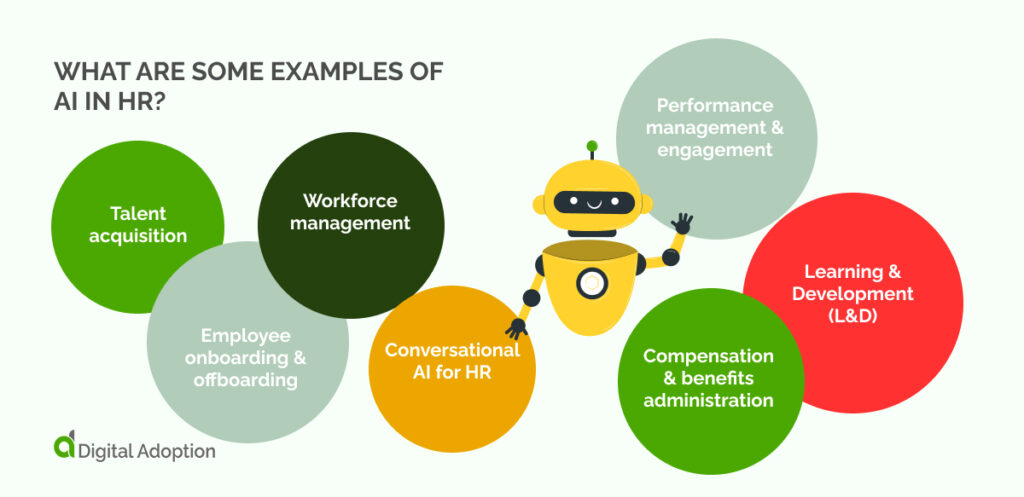
Despite material concerns—not just implementation but those that extend to data privacy, ethics, and future regulation—AI’s introduction across industries is at full throttle.
Like most other industries, AI’s value proposition currently outweighs a pursuit of incremental adoption. To understand what motivates this push, let’s explore some examples of how AI boosts HR capabilities today.
Talent acquisition
More manual talent acquisition methods are being replaced with AI, which now automates candidate sourcing and screening. AI can scan resumes to align potential candidate’s skills and experience with job requirements.
This helps HR recruitment teams minimize vetting periods. AI can expertly determine a candidate’s fit by analyzing historical hiring data and job performance metrics. It also ensures HR teams cut through the noise and source the most promising applicants. Over time, this can enhance workforce quality and reduce turnover rates.
Employee onboarding & offboarding
AI-driven onboarding systems personalize the onboarding process. They provide new hires with tailored information and resources, guiding them through paperwork and training.
For offboarding, AI can automate exit interviews and ensure all necessary steps are completed, such as returning equipment and revoking access. This makes transitions smooth and ensures compliance with company policies.
Workforce management
AI optimizes workforce management by predicting staffing needs and scheduling shifts efficiently. It considers factors like employee availability, skills, and historical data to create balanced schedules.
This minimizes labor costs and ensures adequate coverage during peak times. AI also helps identify patterns in absenteeism or turnover, allowing HR to address issues proactively.
Conversational AI for HR
Conversational AI, such as chatbots, provides employees with instant responses to HR-related queries. This includes information on company policies, benefits, and procedures. Chatbots can assist with tasks like booking time off or updating personal details.
This reduces the burden on HR staff and ensures employees get timely support, improving overall satisfaction.
Performance management & engagement
AI enhances performance management by offering real-time feedback and analytics. It tracks employee performance against set goals and provides insights into areas for improvement.
AI can identify patterns in employee engagement and suggest interventions to boost morale. This leads to more effective performance reviews and a motivated workforce.
Compensation & benefits administration
AI simplifies compensation and benefits administration by automating payroll and benefits calculations. It ensures accuracy in payments and compliance with regulations.
AI can also analyze market data to recommend competitive salary adjustments. This helps retain top talent and aligns compensation with industry standards.
Learning & Development (L&D)
AI personalizes learning and development programs by identifying individual skill gaps and recommending targeted training. It can track progress and adapt content to the learner’s pace.
AI also predicts future skill needs based on industry trends, helping organizations stay ahead. This fosters continuous improvement and career growth for employees.
What AI applications are used in HR?
We’ve explored the various use cases and application areas for AI in supporting HR functions. Given AI’s transformative potential, its broader economic implications are significant.
Goldman Sachs forecasts a major economic impact from Generative AI. Their analysis suggests that it could lift global worker productivity by over 1% annually after widespread adoption, triggering global investments reaching nearly $200 billion by 2025.
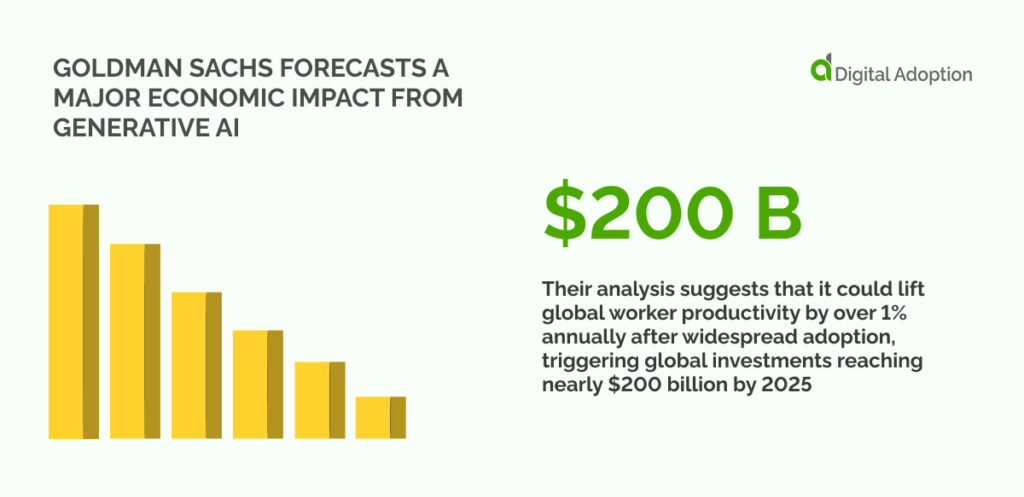
Let’s now take a look at the practical tools and applications used to facilitate changes across these domains.
Textio
Capturing prospective talent requires understanding exactly what is needed in the role. For employers, Textio enhances job descriptions and emails. It uses AI to suggest language that attracts diverse candidates. Through word analysis, it forecasts how well a job post will perform. Textio helps companies advertise positions in a way that resonates more effectively with job seekers. HR leaders can use this tool during the attraction stage of the employee lifecycle.
Kazoo
Kazoo is an Employee Experience Platform focusing on employee engagement and recognition through AI. It strengthens company culture by combining features for real-time feedback, goal tracking, and peer recognition. It provides a single solution for deploying personalized incentives and combining goals and OKRs. It can also be integrated with HRIS and HCM systems. Ultimately, Kazoo helps improve employee satisfaction by making recognition a part of daily interactions.
Leena AI
Leena AI delivers automated HR employee services. Its virtual assistant answers employee queries in real-time, handles leave requests and manages policy information. This minimizes workloads for HR teams, allowing them to focus on high-value tasks. Employees benefit from quick, accurate responses, speedy query resolution, and information access. Leena AI is a main contender, helping HR teams improve employee experience and engagement.
Sanka
Sanka leverages AI to extract meaning from HR analytics. This commerce management platform collects and analyzes employee data, providing insights into performance, engagement, and retention. This helps HR professionals make informed decisions about workforce management. With Sanka, organizations can proactively identify trends and address issues, leading to a more productive and satisfied workforce.
Beamery
Beamery helps HR leaders address and remedy talent and skills gaps. It tracks candidates from first contact through the hiring process. AI identifies passive candidates, improving the efficiency of talent pipelines. Beamery also offers insights into candidate engagement. This app helps recruiters refine their outreach strategies and build stronger relationships with top talent, which is especially useful during the recruitment stage of the employee lifecycle.
HiBob
HiBob cleverly employs AI to streamline several HR processes. Its AI features automate administrative tasks like payroll and benefits management. The platform also provides insights into employee engagement and performance. HiBob’s award-winning HRIS platform simplifies life for HR teams, boosting efficiency and productivity by optimizing processes. Now, with the integration of powerful AI from Kindo, HiBob empowers HR to personalize employee experiences, driving engagement and retention.
Greenhouse
Greenhouse enhances recruitment efficiency using various AI features. Their automation resources help with candidate sourcing, job post optimization, and interview scheduling. The platform also provides actionable insights into the hiring process, allowing recruiters to make data-based decisions. Greenhouse ensures that companies can identify and hire the best candidates quickly and effectively.
Paradox
Paradox improves the hiring process with its AI assistant, Olivia. Olivia handles candidate screening, scheduling, and follow-ups, reducing the time and effort required from recruiters. This leads to faster hiring decisions and a better candidate experience. Paradox helps organizations attract and retain top talent with minimal administrative burden.
Personio
Personio offers an all-in-one HR solution. Its AI capabilities streamline recruitment, onboarding, and payroll processes. The tool also helps with performance reviews and employee development plans. Personio’s comprehensive approach ensures that HR tasks are handled efficiently, allowing organizations to support their workforce and drive growth.
eduMe AI
eduMe AI enhances employee training. The platform uses AI to create personalized learning paths based on individual needs and career goals. It tracks progress and provides feedback, helping employees improve their skills efficiently. This targeted approach ensures that training resources are used effectively, improving development outcomes.
Rypple
Rypple focuses on employee feedback and performance management. Its AI-enabled leadership platform delivers real-time guidance, progress tracking, goal setting, and performance reviews. This helps managers manage the employee lifecycle and ensures employees stay aligned on objectives. Rypple evolves alongside the professional journey, highlighting milestones and achievements. This leads to higher employee engagement, morale, and down-the-line performance.
HireVue
HireVue enhances HR processes with its video interviewing platform embedded with AI. It uses AI to analyze candidates’ speech, tone, and facial expressions during interviews to provide insights into their potential fit for a role. The platform helps standardize the interview process, reducing bias and improving the quality of hires. HireVue also integrates with other HR systems to streamline the recruitment workflow, making it a valuable tool for organizations looking to modernize their hiring practices.
Eightfold AI
Eightfold AI enhances talent management with deep learning technology. This talent intelligence platform analyzes data from resumes, job descriptions, and career paths to match candidates with suitable roles. The platform offers talent rediscovery features and diversity hiring tools to reduce bias. Eightfold AI supports continuous employee growth by identifying potential career paths and development opportunities within the organization.
Talmundo
Talmundo focuses on employee onboarding. It personalizes the onboarding experience, automates admin tasks, standardizes processes, and provides new hires with tailored content. This reduces the pressure on HR teams and helps new employees integrate smoothly into their roles. Overall, job satisfaction and productivity result. HR teams primarily leverage Talmundo for onboarding and offboarding processes.
Pymetrics
Pymetrics AI improves hiring and employee placement using neuroscience-based games and AI analysis. Candidates’ cognitive and emotional traits are assessed through games, and the AI matches them to roles where they are likely to excel. This method reduces hiring bias and enhances job fit. Pymetrics also provides insights into team dynamics, helping improve overall team performance and cohesion.
AI’s future impact on HR
Executives surveyed by World Bank Statistics reveal that up to 40% of their workforce will require reskilling due to automation and AI within the next three years. This could impact a significant portion of the global workforce, potentially reaching 1.4 billion out of 3.4 billion workers.
A discourse will be needed to set up tangible precautions and parameters that inform AI’s impaed. A fair percentage of these impacts will revolve around data privacy, misinformation, regulatory compliance, etc.
Evaluating AI risks and their potential impact is key, especially given its potential reliance on high-stakes applications. The consequences of AI producing inaccurate outputs can mean life or death in fields like healthcare. For HR, relying on skewed AI can make processes tangled and unwieldy.
Going forward, implementing AI in HR requires balancing responsibility and innovation. On one hand, HR teams must know how to adopt AI in a way that directly benefits business needs. This means figuring out how to derive the most value from AI and reinvesting those gains in other business areas.
When done right, AI can drive innovation in HR, resulting in wins for efficiency, productivity, and employee satisfaction. AI technologies mean organizations can become future-ready.
For HR teams, it means they can meet the challenges and opportunities of tomorrow’s workforce.

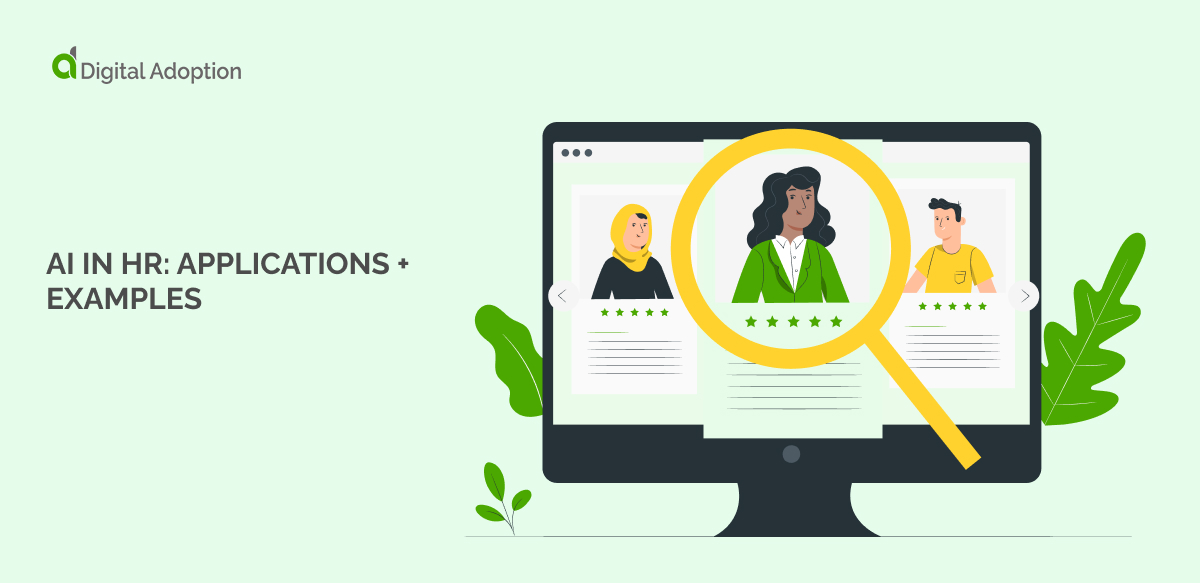


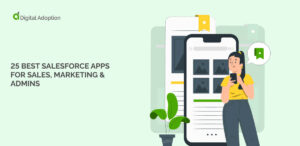
![13 AI Examples in Industry [2025]](https://www.digital-adoption.com/wp-content/uploads/2025/07/AI-Examples-in-Industry-300x146.jpg)
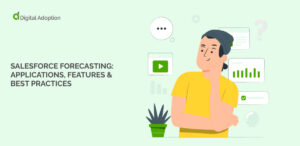
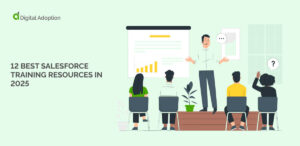
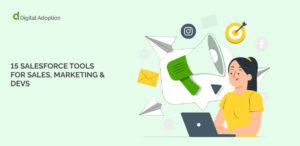
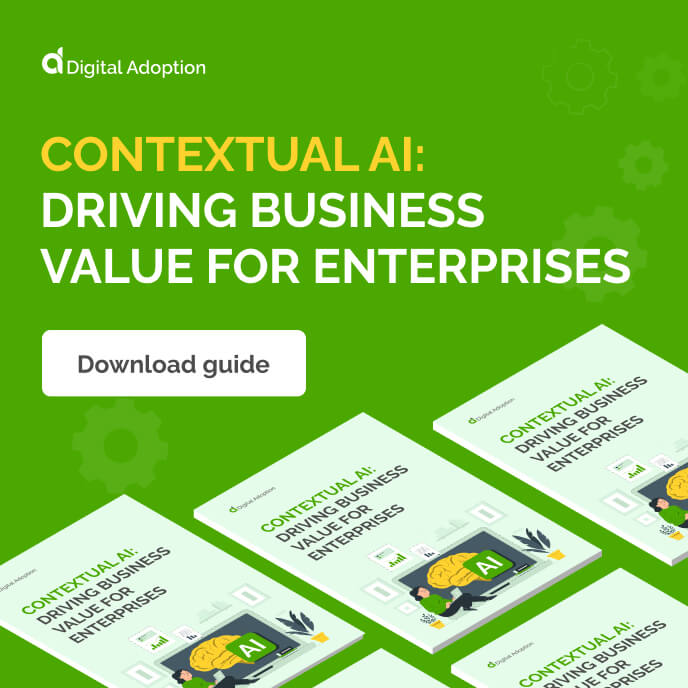

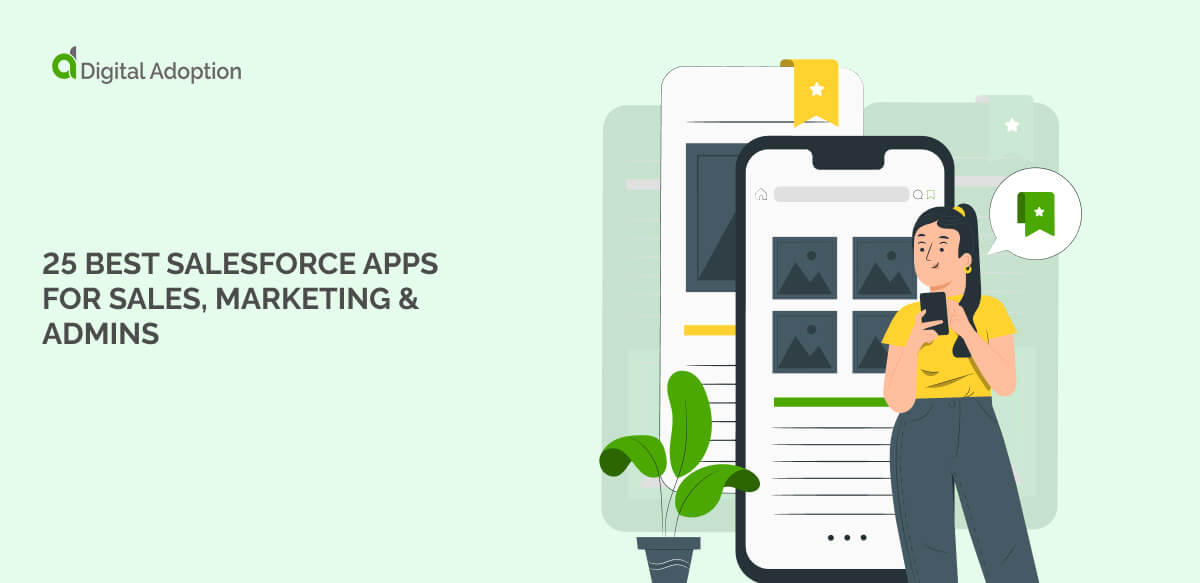
![13 AI Examples in Industry [2025]](https://www.digital-adoption.com/wp-content/uploads/2025/07/AI-Examples-in-Industry.jpg)
